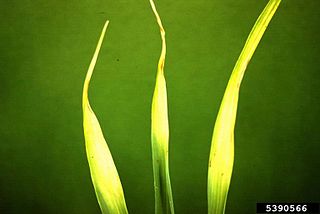Related Research Articles

Narcissus is a genus of predominantly spring flowering perennial plants of the amaryllis family, Amaryllidaceae. Various common names including daffodil, narcissus, and jonquil are used to describe all or some members of the genus. Narcissus has conspicuous flowers with six petal-like tepals surmounted by a cup- or trumpet-shaped corona. The flowers are generally white and yellow, with either uniform or contrasting coloured tepals and corona.

A leaf spot is a limited, discoloured, diseased area of a leaf that is caused by fungal, bacterial or viral plant diseases, or by injuries from nematodes, insects, environmental factors, toxicity or herbicides. These discoloured spots or lesions often have a centre of necrosis. Symptoms can overlap across causal agents, however differing signs and symptoms of certain pathogens can lead to the diagnosis of the type of leaf spot disease. Prolonged wet and humid conditions promote leaf spot disease and most pathogens are spread by wind, splashing rain or irrigation that carry the disease to other leaves.

Root-knot nematodes are plant-parasitic nematodes from the genus Meloidogyne. They exist in soil in areas with hot climates or short winters. About 2000 plants worldwide are susceptible to infection by root-knot nematodes and they cause approximately 5% of global crop loss. Root-knot nematode larvae infect plant roots, causing the development of root-knot galls that drain the plant's photosynthate and nutrients. Infection of young plants may be lethal, while infection of mature plants causes decreased yield.

Pratylenchus penetrans is a species of nematode in the genus Pratylenchus, the lesion nematodes. It occurs in temperate regions worldwide, regions between the subtropics and the polar circles. It is an animal that inhabits the roots of a wide variety of plants and results in necrotic lesions on the roots. Symptoms of P. penetrans make it hard to distinguish from other plant pathogens; only an assay of soil can conclusively diagnose a nematode problem in the field. P. penetrans is physically very similar to other nematode species, but is characterized by its highly distinctive mouthpiece. P. penetrans uses its highly modified mouth organs to rupture the outer surface of subterranean plant root structures. It will then enter into the root interior and feed on the plant tissue inside. P. penetrans is considered to be a crop parasite and farmers will often treat their soil with various pesticides in an attempt to eliminate the damage caused by an infestation. In doing this, farmers will also eliminate many of the beneficial soil fauna, which will lead to an overall degradation of soil quality in the future. Alternative, more environmentally sustainable methods to control P. penetrans populations may be possible in certain regions.
Aphelenchoides arachidis is a plant pathogenic nematode.

Aphelenchoides besseyi is a plant pathogenic nematode. It is sometimes referred to as rice white tip, spring dwarf, strawberry bud, flying strawberry nematode or strawberry crimp disease nematode. This foliar nematode is found in Africa, North, Central, and South America, Asia, Eastern Europe, and Pacific islands.
Aphelenchoides coffeae is a plant pathogenic nematode.
Aphelenchoides parietinus is a plant pathogenic nematode.

Tobacco rattle virus (TRV) is a pathogenic plant virus. Over 400 species of plants from 50 families are susceptible to infection.
Raspberry ringspot virus (RRSV) is a plant pathogenic virus of the family Secoviridae. It was first described by Cadman in 1958. It causes ringspots in raspberries and strawberries and can cause rasp-leaf symptoms in cherry. It also has been found in many other plants including those in the Vitis and Narcissus genera. There are many strains of the virus, the most important including the Scottish strain, the English strain, and the Lloyd George yellow blotch strain. The Scottish strain is the type virus.

Foliar nematodes are plant parasitic roundworms in the genus Aphelenchoides. The three most economically important species are Aphelenchoides fragariae, A. ritzemabosi, and A. besseyi. Foliar nematodes are becoming a widespread and serious problem for the ornamental and nursery industries. A. fragariae causes damage on hundreds of different plants including chrysanthemum, begonia, gloxinia, African violet, cyclamen, and a wide variety of bedding plants and ferns, causing brown to black, vein-delimited lesions on leaf tissue, defoliation, and possible stunting of plants.
Fern nematode may refer to:

Bursaphelenchus xylophilus, commonly known as pine wood nematode or pine wilt nematode (PWN), is a species of nematode that infects trees in the Pinus genus of coniferous trees and causes the disease pine wilt. While native to North America, it spread in the early 20th century to Japan and in the latter half of the century to other areas of Asia, including China, Taiwan and Korea, as well as to Europe, including Portugal and Spain.

The nematodes or roundworms constitute the phylum Nematoda, with plant-parasitic nematodes also known as eelworms. They are a diverse animal phylum inhabiting a broad range of environments. Less formally, they are categorized as Helminths, but are taxanomically classified along with arthropods, tardigrades and other moulting animals in the clade Ecdysozoa, and unlike flatworms, have tubular digestive systems with openings at both ends. Like tardigrades, they have a reduced number of Hox genes, but their sister phylum Nematomorpha has kept the ancestral protostome Hox genotype, which shows that the reduction has occurred within the nematode phylum.
Aphelenchoides is a genus of mycetophagous nematodes. Some species are plant pathogenic foliar nematodes.
Antarctica is one of the most physically and chemically extreme terrestrial environments to be inhabited by lifeforms. The largest plants are mosses, and the largest animals that do not leave the continent are a few species of insects.

Aphelenchoididae is a nematode family in the order Aphelenchida.
Longidorus is a genus of needle nematodes. Some of its species are plant pests.
Aphelenchoides bicaudatus is a nematode parasite of Elaeidobius kamerunicus, Vigna marina, and Agaricus bisporus.